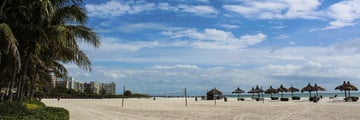Exploring Fort Myers' enchanting nature trails
Blessed with warm sunny weather year-round, diverse landscapes brimming with lush foliage, and an abundance of wildlife, Fort Myers and its surrounding communities are prime destinations for outdoor enthusiasts in search of memorable natural encounters. There’s a whole wealth of protected reserves and recreational parks waiting to be discovered, along with long stretches of undisturbed coastline, scenic inland waterways, glorious beaches and countless secluded islands.
Thanks to the efforts of Lee County, much of the area remains in a pristine state and protected from development, whilst a large network of multi-use trails provide easy access to miles of mangrove swamps, pine forests, subtropical hammocks, grasslands and sandy shorelines. What’s more, Fort Myers is an outstanding place to witness some of Florida’s most iconic fauna, from water dwelling manatees, turtles and alligators, to racoons, armadillos, snakes and over 400 species of birds.
Whether you fancy lacing up your hiking boots or taking to two wheels, Fort Myers provides a gateway to some of Florida’s most diverse and enchanting natural habitats. Here’s a rundown of some of the best areas not to be missed.

Fort Myers
Situated on Estero Island, just a short hop from the mainland, Fort Myers Beach is a seven-mile strip of coastline filled with family-friendly resorts, a smattering of fantastic seafood restaurants and plenty of opportunities for beachside fun. It’s also the ideal place to come for a spot of casual walking and cycling, whether it be a leisurely oceanside bike ride or evening strolls along the beach at sunset.
Those looking for something a little more adventurous should head to the nearby Estero Bay & Scrub Preserve State Parks, located on the mainland directly opposite Fort Myers Beach. Established in 1966 as Florida’s first aquatic preserve, the area protects a delicate estuary ecosystem featuring flatwood and tidal marshes, with several hiking loops bordering the bay’s rim. It’s a wild trek through muddy and often submerged pathways that require some wading, so be sure to come prepared. An array of birdlife and dragonflies can be seen along the way, and there are also places to launch a kayak to further explore the tidal waters – and potentially spot some manatees and dolphins if you’re lucky!
For some of the best nature trails in the area, be sure to check out Lovers Key State Park, a pristine tract of wilderness featuring mangroves, lush broadleaf forest and a remote beach that will bring you right back to the “old” Florida. There are over 5 miles of multi-use trails for hiking and bicycling, including the Black Island and Eagle Trails. Both wind and twist through a charming maritime hammock bordering inner waterways, transitioning between grass, sand and mud pathways. En route, you’ll pass freshwater ponds and plenty of observation points with comfortable benches for wildlife viewing, including marsh rabbits, ospreys, bald eagle and alligators. Bike tours are available to guide you through the park, or you can opt to rent a bicycle from Lovers Key Adventures. To recuperate after a busy day exploring, spend some time shelling, swimming, picnicking and sunbathing on the island’s beautiful beach.

Another must-visit for nature lovers holidaying in Fort Myers, is the Six Mile Cypress Slough Preserve that protects over 2,000 acres of wildlife rich cypress marsh. In fact, the Six Mile Cypress Trail, whilst being short and easy, is recognised as one of the most rewarding hikes in the entire state. The boardwalk trail offers full immersion in a peaceful watery wilderness whilst keeping you high and dry well above the marshy terrain. Take your time navigating the route, approach quietly and you’ll spy alligators, herons, ibis, turtles, racoons, frogs and more. Observation decks provide perfect spots for taking it all and capturing perfect snaps of your encounters.

Those looking for more challenge should head to Caloosahatchee Regional Park. Situated to the north-east of Fort Myers, this wild reserve encompasses a beautiful collection of pine flatwoods, wetlands, cypress swamps and oak hammocks. Over 20 miles of trails enable you to discover the diverse landscapes and its wildlife whilst providing an exhilarating workout. The southside is primarily designated for hikers, whilst the north side features a network of singletrack for mountain bikers keen to put their peddling skills to the test. The expansive Caloosahatchee River runs through the park and a rustic campground provides a picturesque base to spend a couple of days exploring.

Sanibel Island
Sanibel is one of Florida’s most popular barrier islands, particularly renowned for its spectacular white sand beaches filled with impressive seashells. It’s also home to the legendary Ding Darling National Wildlife Refuge that protects a large swathe of the island from development and attracts around half a million visitors each year. Sanibel features over 25 miles of multi-use paths that provide easy access to the area’s densely vegetated and wildlife rich habitats. Cyclists in particular will feel right at home here. For years, the island has been recognised as one of the most bike-friendly communities in the US by the League of American Bicyclists.
The main thoroughfare on Sanibel is the Periwinkle Way, the perfect avenue for discovering the island’s main commercial and tourist attractions, including restaurants, shops, museums, landmarks and interpretive centres. Alternatively, take a leisurely ride around the more residential Gulf Drive on the island’s southside, or follow any number of smaller trails leading off the main pathways to access subtropical hammocks and preserved wetlands.
A visit to the Ding Darling Refuge is a must for any nature lover. This park protects one of America’s largest mangrove ecosystems and can be easily explored either on foot or by bike. Shallow estuaries, mangrove forests, seagrass beds and West Indian hardwood hammocks harbour an impressive array of animal species, from otters and sea turtles, to dolphins, manatees and hundreds of species of native and migratory birds. One of the most rewarding routes is the Indigo Trail, a 4-mile round trip via boardwalk pathways that wind through a tropical hammock and mangrove forest, providing abundant wildlife sightings along the way.

Pine Island
The secluded Pine Island is ringed by lush mangrove forests, with an interior consisting mainly of common land filled with tropical foliage and criss-crossed by peaceful waterways. It’s a relatively low-key island, making it the perfect choice for those looking to escape the crowds and development of some other areas.
Hikers should head for the Flatwoods Preserve which features plenty of walking trails weaving through the nine native plant communities that include pine forests, freshwater marshes and tidal swampland. This is a wonderful spot to observe some of Florida’s most fascinating bird species, including pelicans, herons, egrets, osprey and bald eagles. Keen birders should also check out the St. Jude Trail on the island’s southside. On this hike, you’ll progress through thick tropical vegetation and mangrove forest before emerging onto a boardwalk and observation deck that overlooks a picturesque creek providing marvellous views over the surrounding islands.
Meanwhile, cyclists can explore Pine Island via the Stringfellow Trail, a purpose-built concrete bike path that spans the entire length of the island. The route passes near the Flatwoods Preserve, so you can easily combine the two, along with recreational parks, picnic areas, tropical fruit orchards and groves of palm trees. If you’re looking to get even further off the beaten track, Pine Island is also the launching point to reach the remarkable Cayo Costa State Park, a remote barrier island that’s virtually deserted and filled with endless white sand beaches and interior hiking trails that you’re guaranteed to have all to yourself.

Cape Coral
Another designated Bicycle Friendly Community, the scenic city of Cape Coral is especially well suited to those exploring on two wheels. Over 90 miles of interconnected cycling routes weave along beautiful canals and the majestic Caloosahatchee River, taking in expansive waterfront vistas and providing access to numerous ecological parks.
Spend the day cruising along dedicated bike pathways complete with distinctive signage, information kiosks, plenty of interesting landmarks and endless opportunities for additional recreational activities, whether it be kayaking, boating, golfing or birdwatching. Make a stop at Rotary Park, home to mangroves, waterways, an observation tower, butterfly house and kid’s playground. Another must-visit is the pristine Four Mile Cove Ecological Park, featuring boardwalk and nature trails through a stunning mangrove forest.
After a busy day of adventure, treat yourself in the speciality boutiques, cosy coffee shops and enticing waterfront restaurants that line Cape Coral’s attractive marinas. Riverfront beaches, fishing piers, waterparks, along with yacht and golf clubs, provide yet more venues to blow off steam or simply relax in the sun and soak in the beautiful natural surrounds.

More Inspiration
Recommended holidays













